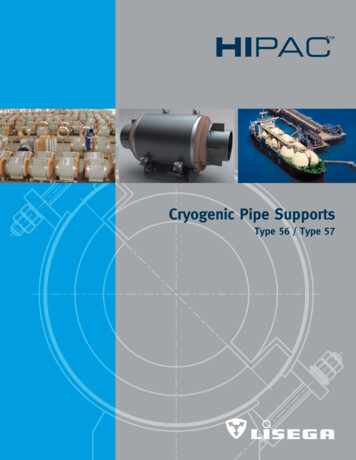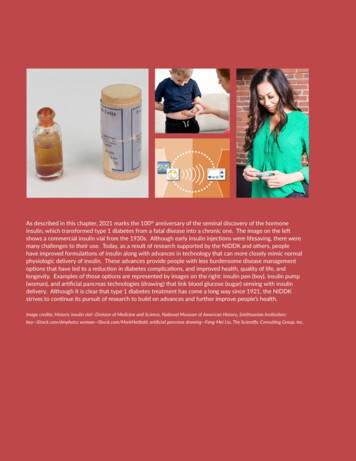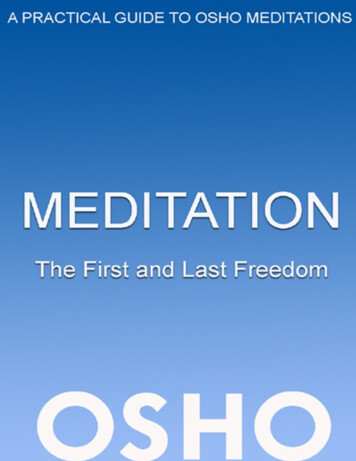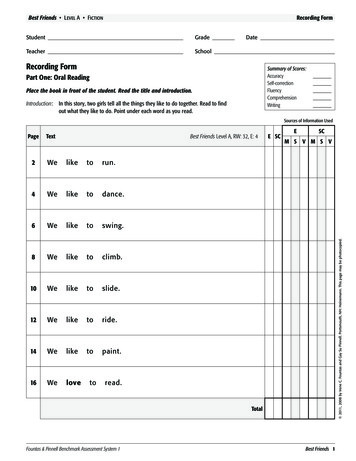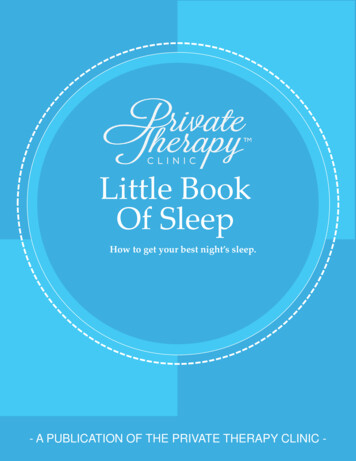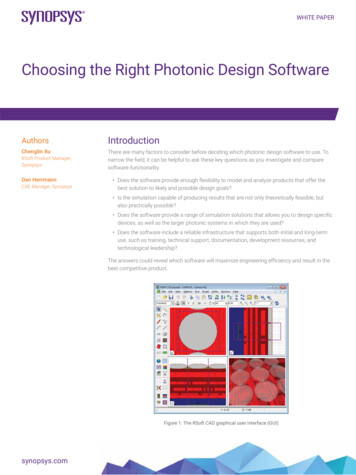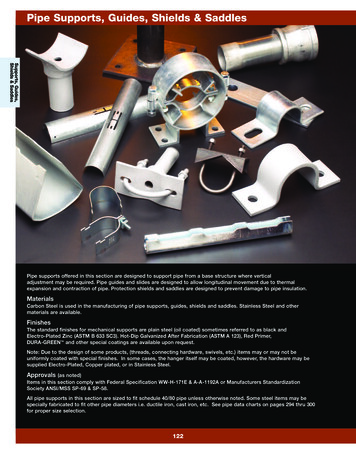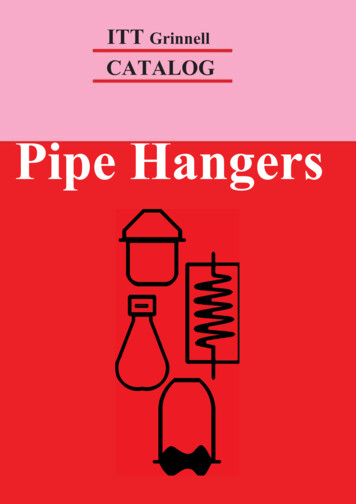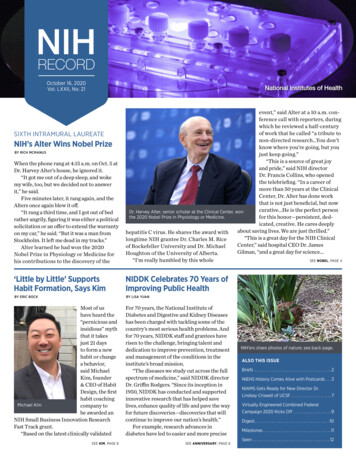
Transcription
October 16, 2020Vol. LXXII, No. 21When the phone rang at 4:15 a.m. on Oct. 5 atDr. Harvey Alter’s house, he ignored it.“It got me out of a deep sleep, and wokemy wife, too, but we decided not to answerit,” he said.Five minutes later, it rang again, and theAlters once again blew it off.“It rang a third time, and I got out of bedrather angrily, figuring it was either a politicalsolicitation or an offer to extend the warrantyon my car,” he said. “But it was a man fromStockholm. It left me dead in my tracks.”Alter learned he had won the 2020Nobel Prize in Physiology or Medicine forhis contributions to the discovery of theevent,” said Alter at a 10 a.m. conference call with reporters, duringwhich he reviewed a half-centuryof work that he called “a tribute tonon-directed research You don’tknow where you’re going, but youjust keep going.”“This is a source of great joyand pride,” said NIH directorDr. Francis Collins, who openedthe telebriefing. “In a career ofmore than 50 years at the ClinicalCenter, Dr. Alter has done workthat is not just beneficial, but nowcurative He is the perfect personDr. Harvey Alter, senior scholar at the Clinical Center, wonthe 2020 Nobel Prize in Physiology or Medicine.for this honor—persistent, dedicated, creative. He cares deeplyaboutsavinglives. We are just thrilled.”hepatitis C virus. He shares the award with“Thisisagreatday for the NIH Clinicallongtime NIH grantee Dr. Charles M. RiceCenter,”saidhospitalCEO Dr. Jamesof Rockefeller University and Dr. MichaelGilman,“andagreatdayfor science Houghton of the University of Alberta.“I’m really humbled by this wholeSEE NOBEL, PAGE 4‘Little by Little’ SupportsHabit Formation, Says KimNIDDK Celebrates 70 Years ofImproving Public HealthBY ERIC BOCKBY LISA YUANMost of ushave heard the“pernicious andinsidious” myththat it takesjust 21 daysto form a newhabit or changea behavior,said MichaelKim, founder& CEO of HabitDesign, the firsthabit coachingMichael Kimcompany tobe awarded anNIH Small Business Innovation ResearchFast Track grant.“Based on the latest clinically validatedFor 70 years, the National Institute ofDiabetes and Digestive and Kidney Diseaseshas been charged with tackling some of thecountry’s most serious health problems. Andfor 70 years, NIDDK staff and grantees haverisen to the challenge, bringing talent anddedication to improve prevention, treatmentand management of the conditions in theinstitute’s broad mission.“The diseases we study cut across the fullspectrum of medicine,” said NIDDK directorDr. Griffin Rodgers. “Since its inception in1950, NIDDK has conducted and supportedinnovative research that has helped savelives, enhance quality of life and pave the wayfor future discoveries—discoveries that willcontinue to improve our nation’s health.”For example, research advances indiabetes have led to easier and more preciseSIXTH INTRAMURAL LAUREATENIH’s Alter Wins Nobel PrizeBY RICH MCMANUSSEE KIM, PAGE 8SEE ANNIVERSARY, PAGE 6NIH’ers share photos of nature; see back page.ALSO THIS ISSUEBriefs . . . . . . . . . . . . . . . . . . . . . . . . . . . . . . . . . . . . 2NIEHS History Comes Alive with Postcards. . . 3NIAMS Gets Ready for New Director Dr.Lindsey Criswell of UCSF. . . . . . . . . . . . . . . . . . . 7Virtually Engineered Combined FederalCampaign 2020 Kicks Off . . . . . . . . . . . . . . . . . . 9Digest. . . . . . . . . . . . . . . . . . . . . . . . . . . . . . . . . . . 10Milestones. . . . . . . . . . . . . . . . . . . . . . . . . . . . . . . . 11Seen. . . . . . . . . . . . . . . . . . . . . . . . . . . . . . . . . . . . . 12
BRIEFSNAPA Honors CIT’s NorrisAndrea Norris, director of the Center forInformation Technology and NIH’s chief informationofficer, was among 45 new members elected tothe National Academy of Public Administration(NAPA). Induction of the new fellows will occurduring the academy’s annual fall meeting, whichwill take place virtually Nov. 5-10.Selection of new fellows follows a rigorous reviewof the individual’s contributions to the field ofpublic administration andpolicy.The 2020 classjoins more than940 academyfellows, includingformer cabinetofficers, membersof Congress,governors,mayors and statelegislators, aswell as prominentAndrea Norrisscholars, businessexecutives, nonprofit leaders and public administrators.Chartered by Congress to provide non-partisanexpert advice, NAPA is an independent, non-profitand non-partisan organization established in 1967to assist government leaders in building moreeffective, efficient, accountable and transparentorganizations.NIH Labs Win 2020 International FreezerChallenge AwardThe International Institute for SustainableLaboratories (I2SL) hosts an annual freezerchallenge (www.freezerchallenge.org) in whichthousands of labs from private companies, universities and government organizations compete to seewho can reduce the most energy consumed by thefreezers in their labs.Four NIH labs competed in the 2020 I2SL FreezerChallenge. Through their combined efforts, NIHwon the challenge in the government organizationThe NCI Laboratory of Cell Biology, led byDr. Michael Gottesman (c), won a prize in thefreezer challenge.2 NIH RECORD OCTOBER 16, 2020category.Also, the NCILaboratory ofCell Biology, ledby NIH deputydirector for intramural researchDr. MichaelGottesman, wonthe challenge inthe individualgovernmentlaboratorycategory.The otherthree labs thatparticipated are:A ULT freezerNCI Laboratoryof HumanCarcinogenesis, NHGRI reproductive cancer genetics section and NIDDK genetics and metabolismsection, within the Liver Disease Branch.A few of the notable initiatives they completedinclude: discarded 18,356 1.5-ml samples; retired12 freezers; and changed the temperature settingfrom (-80 C) to (-70 C) on 21 ultra-low temperature(ULT) freezers. Their combined efforts will save NIHan estimated 134,681 kWh/year, 14,815/year and56.6 MTCO2e greenhouse gas emissions/year.More information is detailed in the 2020 FreezerChallenge results page at hallengeResults.aspx.linked to a breakdown in the waybrain cells disposeof damaged powerplants, calledmitochondria.The results havehelped researchers not onlyunderstand therole the genes playin the healthy anddiseased brain butalso explore newtreatment ideasfor Parkinson’sdisease and otherdisorders that arelinked to damagedmitochondria.Youle has servedNIH since 1978. Over the years, he has studied awide range of subjects including the immunologyof bone marrow transplantation, therapies for braintumors and programmed cell death.Before arriving at NIH, he received an A.B. fromAlbion College and a Ph.D. from the University ofSouth Carolina. He has trained dozens of scientists,published more than 180 peer-reviewed researcharticles and has been awarded 16 patents. Healso received several awards, including three NIHDirector’s Awards.Volkow on Listof ‘10 HispanicPioneers inMedicine’To sign up for the 2021 freezer challenge, allenge/lists/Freezer Challenge Sign Up/NewForm.aspx.Youle Receives 2021 Breakthrough Prizein Life SciencesDr. Richard Youle, a senior investigator at theNational Institute of Neurological Disordersand Stroke, is one of four recipients of the 2021Breakthrough Prize in Life Sciences.The Breakthrough Prizes were started in 2012 to“honor important, primarily recent, achievements inthe categories of fundamental physics, life sciencesand mathematics.” Youle will receive a 3 millionaward “for elucidating a quality control pathwaythat clears damaged mitochondria and therebyprotects against Parkinson’s disease.” Previously,laureates were also honored with a televised,Oscar-style award show. Due to the Covid-19 pandemic, this year’s ceremony has been postponeduntil March 2021.Youle leads a team of researchers that studies howgenetic mutations may cause Parkinson’s disease.About 500,000 Americans are currently diagnosedwith Parkinson’s disease. The Breakthrough Prizehonors discoveries made by the Youle lab thatshow how certain disease-causing mutations ingenes called PINK1 and Parkin may harm the brain.Their results suggest that the mutations may beDr. Richard YouleDr. Nora VolkowIn celebration ofNational HispanicHeritage Month,the Association ofAmerican MedicalColleges honoredNIDA director Dr.Nora Volkow asone of the top 10Hispanic pioneersin medicine.A prolific researcher—she has published more than780 peer-reviewed papers—Volkow has led theNational Institute on Drug Abuse since 2003.Her work on addiction is personal. A beloved unclewas ostracized because of his alcoholism and hergrandfather had been an alcoholic and died bysuicide. “Drug addiction is a disease,” she says.To learn about the company she joins,visit -pioneers-medicine.
30th year at NIEHS. “I started as an intern in 1991and never left,” he said. He is well known in Durhamfor being what he calls a street historian. “I like theterm. I don’t want to pretend that I’m a Ph.D.”NIEHS History ComesAlive with PostcardsBY JOHN YEWELL“When John and I began working together, heknew that I was new to the area, and he was quickto offer me a ‘windshield tour’ of Durham,” saidOSED director Dr. Ericka Reid. “It was my first introduction to the city’s history and how it connects toNIEHS. I always refer to him as ‘Mr. Durham’ and theinstitute’s resident historian. Our visitors enjoy himvery much. He is our absolute go-to for tours andinformation sessions.”NIEHS and the Durham, N.C., communityrecently were treated to an online tour oftheir common past. John Schelp, specialassistant for community engagementand outreach in the institute’s Office ofScience Education and Diversity (OSED),narrated “Postcards from Durham,” a3-part history series.In addition to conducting some 60 NIEHS campustours each year and showing institute visitors thelocal area, Schelp gives regular neighborhoodwalking tours.He covered the beginnings of Research“This postcard doesn’t indicate a date, but it is most likelyTriangle Park (RTP) and the effects ofpre-1992,” said Schelp.NIEHS coming to the Tar Heel State,among other topics. Schelp usedIn January 1965, a federal committee recompostcards from his private collection to enhancemended that NIH build its new environmentalthe learninghealthsciences center in RTP. On Gov. Sanford’sexperience.last day in office, he and the U.S. surgeon generalPreservationshared the news publicly.Durham andthe Museum ofDurham Historysponsored hispresentations.The story beginswith an April 1960meeting betweenRobert Kennedy,brother of thefuture president,and TerrySanford, thena former statesenator runningJohn Schelpfor governor, atPHOTO: STEVE MCCAWthe College Innin Raleigh. At theDemocratic convention 3 months later, Sanfordendorsed John F. Kennedy, who carried NorthCarolina and won the election.“We don’t know what was discussed in that Aprilmeeting, but whatever goodwill the endorsementearned Sanford bore fruit 4½ years later,” saidSchelp.“The city has changed so much,” he said. “The Dukefamily used to control 90 percent of the world’scigarettes. Now, it’s illegal to smoke on a Durhamsidewalk.”Watch his presentation at https://www.youtube.com/watch?v R1GTFdRh3Ug.ON THE COVER: Kidney on a chip.IMAGE: UNIVERSITY OF WASHINGTON, NIH SUPPORTFROM NCATSSchelp shared a postcard of the College Inn,where Sanford met Kennedy.The NIH Record“NIEHS was the first major organization toannounce they were coming to RTP,” said Schelp.“IBM announced 6 weeks later and started buildingfirst. That one-two punch transformed the area intoan economic engine of North Carolina. Others werehere, but they were smaller at the time.”Since 1949, the NIH Record has been publishedbiweekly by the Editorial Operations Branch,Office of Communications and Public Liaison,National Institutes of Health, Department of Healthand Human Services. For editorial policies, emaileditor or phone (301) 496-2125.Editor: Rich McManusRich.McManus@nih.govA 509-acre parcel was designated as the future home ofwhat is now NIEHS. Constructionbegan in 1977, and the newcampus welcomed its firstscientists in 1983.This early 20th century postcard draws attention to educationalinstitutions open then in Durham.Schelp’s passion for Durhamhistory began when he moved totown and purchased a Sears andRoebuck home that had beenused as a parsonage for the WestDurham Church of God. “Fromthere, my interest expanded to myformer mill village neighborhoodand then to the rest of the city,”he said.Associate Editor: Carla GarnettCarla.Garnett@nih.govStaff Writers:Eric Bock Eric.Bock@nih.govDana Talesnik Dana.Talesnik@nih.govSubscribe via email:listserv@list.nih.govFacebook “f ” LogoCMYK / .epsFacebook “f ” LogoFollow:http://nihrecord.nih.gov/CMYK / .epsThe NIH Recordis recyclable asmixed paper.The year 2020 marks Schelp’sNIH RECORD OCTOBER 16, 2020 3
NobelCONTINUED FROM PAGE 1[Alter] is somebody that everybody at theClinical Center has not only respect, butalso affection, for. He’s one of the really goodguys, with a sense of humor, approachabilityand accessibility. I couldn’t be prouder of theClinical Center or the department of transfusion medicine. We are very grateful forhaving had the chance to get to know him.”“What a treat!” enthused Dr. John Gallin,who directed the CC for much of Alter’scareer and is now NIH associate director forclinical research. “He is the consummateclinical investigator, a wonderful physicianwho cares passionately about his patients.Ibelieve that his work could not have beendone easily anywhere else in the world.”Alter had planned on a career in clinicalmedicine when he arrived at the NIH bloodbank in 1969. But while working with Nobellaureate Dr. Baruch Blumberg, he foundan interesting antigen. “It was the surfacecoating of the hepatitis B virus,” he said, andit proved to be the basis for a test to keepdonated blood safe.The excitement of the discovery changedhis career path. He and his blood bankcolleagues began following patients afterthey had undergone open-heart surgery atNIH, because about a third of such patientslater developed liver abnormalities resembling hepatitis. The scientists were keen todiscover the cause.For 6 months, they checked on thesepatients weekly and stored their bloodsamples.The Royal Swedish Academy of Sciencessaid, “Prior to their work, the discovery of theHepatitis A and B viruses had been criticalsteps forward, but the majority of blood-bornehepatitis cases remained unexplained. Thediscovery of Hepatitis C virus revealed the causeof the remaining cases of chronic hepatitis andmade possible blood tests and new medicinesthat have saved millions of lives.”PHOTOS: CHIA-CHI CHARLIE CHANG“We were astounded to find that 30percent later got hepatitis,” said Alter.Further investigation revealed that, ifthe patients had received blood from paiddonors, they had a 51 percent chance ofacquiring hepatitis, versus only a 7 percentchance if the donors were volunteers. So in1970, the NIH blood bank adopted a policy ofall-volunteer donations if patients were to belater transfused. That year, the first test forhepatitis B debuted, causing “a precipitousdrop [in post-surgical cases of hepatitis], to10 percent,” said Alter.But it didn’t go to zero. What else wasgoing on?“In the ensuing years,we didn’t know where wewere going,” he said, butthe scientists kept up theirsearch for all causes ofpost-transfusion hepatitis.In the mid-1970s at NIH,researchers discoveredthe hepatitis A virus. Thatenabled Alter and his teamto take advantage of the“enormous value of storedsamples” to tease outhepatitis cases unrelated toeither the A or B forms—andOn hand for a media telebriefing Oct. 5 in Bldg. 1 were (from l) NIHthere were a lot of those.director Dr. Francis Collins, Alter, NIH associate director for clinicalresearch Dr. John Gallin and Clinical Center CEO Dr. James Gilman.They dubbed the culprit4 NIH RECORD OCTOBER 16, 2020“non-A, non-B hepatitis.”“Fifteen years later, we still didn’t knowwhat the agent was,” he related. But theyknew something about it. Animal studies andfiltration experiments suggested the agentwas a small virus, likely an RNA virus.“We were still stuck through the 1980s,without having really identified the agent,”said Alter. “But then, the field of molecularbiology began to emerge We were upstagedby [co-laureate] Houghton, working atChiron, when they cloned the non-A, non-Bagent,” later known as hepatitis C.The Chiron team developed an antibodyassay that Alter put to the test by pittingit against a coded panel of stored bloodsamples. It found every single case. The testlater became even more sensitive, so thatby 1997, rates of post-transfusion hepatitisdropped virtually to zero, with no casessince, Alter said.Co-laureate Rice provided the ultimateproof that this virus was responsible forhepatitis C by recreating its genome in thelab and showing that it could transmit thedisease to animals. Years later, investigatorsat Gilead developed a game-changing drugwhose effectiveness is now at almost 100percent, said Alter. “We can cure almost allcarriers. It may be possible even to eradicatethis disease in the next decade, even in theabsence of a vaccine. A vaccine is still thegoal, though.”During a Q&A session with reporters,Alter, 85, acknowledged, “I’m sort of on thedownslope of my career” as he finishes workon his longtime cohort of patients. “All ofthem are cured,” he said. “It’s so dramatic.It was the greatest thrill, to be involved withthe cure of the first patient, then all subsequent patients. I could never have imaginedthis—not in my lifetime.”He thinks a vaccine will be tough todevelop, because the hepatitis C virus “isconstantly mutating. You could kill thedominant strain, but another will come upand keep the infection going. It’s like HIV inthat respect It’s a tough fight. I’m not surewe’ll get to a vaccine. But we don’t need it tocure patients.”Alter said Blumberg taught him animportant early lesson: “If you find something unexpected, keep looking, keeppersisting We were allowed to do researchat NIH, to look for something where youdidn’t know where you were going. It
an immediate [payoff ]. We need tochange that dynamic.”Going forward, Alter said, theissues surrounding hepatitis C“aren’t really about science. We don’tneed better drugs, or tests. We needthe political will to eradicate it. Weneed to make drugs affordable. Weneed the will to do it, and it will take aglobal effort.”Hepatitis C is still with us, stillspreading, especially in the developing world, he warned. “It’s mostlyCo-Nobelists Dr. Michael Houghton (l) and Alter (r) haveshared needle use that keeps it going.a long history of sharing research acclaim. Shown here inWe need to help the drug addict pop2000, they receive the Lasker Award.ulation. They should use disposableequipment,if they are still using drugs.couldn’t happen anywhere else. You don’t“In the third world,” he continued, “weapply for a grant and say, ‘I want to discover aneed to teach health care workers not to usenew virus.’ NIH offers the freedom to pursueneedles or vials over again; for them it is anthings without having an immediate effect.economic issue. Test and treat is the key.”Nowadays, it’s hard to get funding withoutGrantee Shares Nobel Prize in ChemistryDr. Jennifer Doudna, a biochemist with the University ofCalifornia, Berkeley, and a genome editing pioneer, has receivedthe 2020 Nobel Prize in Chemistry “for the development ofa method for genome editing.” She has had continuous NIHfunding since 1997 from NIGMS, NIAID and NHGRI.She shares the honor with Dr. Emmanuelle Charpentier, a Frenchmicrobiologist and a fellow genome editing pioneer with the MaxPlanck Unit for the Science of Pathogens, Berlin, Germany.According to the Royal Swedish Academy of Sciences, Doudnaand Charpentier “have discovered one of gene technology’ssharpest tools: the CRISPR/Cas9 genetic scissors. Using these,researchers can change the DNA of animals, plants and microorganisms with extremely high precision. This technology has hada revolutionary impact on the life sciences, is contributing to newcancer therapies and may make the dream of curing inheriteddiseases come true.”Dr. Jennifer Doudna of theUniversity of California, Berkeley,is shown here giving the annualNIH Director’s Margaret PittmanLecture on Mar. 11, 2015.PHOTO: BILL BRANSON“There is enormous power in this genetic tool, which affects us all,” said Claes Gustafsson, chair ofthe Nobel committee for chemistry. “It has not only revolutionized basic science, but also resulted ininnovative crops and will lead to ground-breaking new medical treatments.”Doudna joined Collins for a live ½-hour Q&Asession on social media the day following theNobel announcement. Topics ranged from covidapplications for CRISPR to its ethical uses.The academy continued, “Since Charpentier andDoudna discovered the CRISPR/Cas9 geneticscissors in 2012, their use has exploded. This toolhas contributed to many important discoveries inbasic research, and plant researchers have beenable to develop crops that withstand mould,pests and drought. In medicine, clinical trialsof new cancer therapies are underway, and thedream of being able to cure inherited diseases isabout to come true. These genetic scissors havetaken the life sciences into a new epoch and, inmany ways, are bringing the greatest benefit tohumankind.”Dozens of NIH-supported scientists from around the world have received Nobel prizes for their groundbreaking achievements in physiology or medicine; chemistry; physics; and economic sciences. To date,163 NIH-supported researchers have been sole or shared recipients of 96 Nobel prizes.The third 2020 co-Nobelist, Dr. Charles Rice,a longtime NIH grantee, gives the KhouryLecture at NIH in 2016.PHOTO: BILL BRANSONA native of New York City, Alter earnedhis medical degree at the University ofRochester Medical School and trainedin internal medicine at Strong MemorialHospital and at the University Hospitals ofSeattle. In 1961, he came to NIH as a clinicalassociate. He then spent several years withGeorgetown University before returningto NIH in 1969 to be a senior investigatorin what became the Clinical Center’sdepartment of transfusion medicine. Helater became chief of DTM clinical studiesand associate director of research in thedepartment. His current title there is seniorscholar.In 2000, Alter was awarded the ClinicalMedical Lasker Award. In 2002, he becamethe first Clinical Center scientist electedto the National Academy of Sciences. Thatsame year, he was elected to the Institute ofMedicine. In 2013, Alter was honored withthe Canada Gairdner International Awardfor his critical contribution to the discoveryand isolation of the hepatitis C virus.Alter is the sixth NIH intramural scientistto win the Nobel Prize, which had not goneto a campus investigator since Dr. MartinRodbell won in 1994. The other intramurallaureates are Dr. D. Carleton Gajdusek(1976), Dr. Christian B. Anfinsen (1972), Dr.Julius Axelrod (1970) and Dr. Marshall W.Nirenberg (1968).Alter’s co-laureate Rice has receivedcontinuous NIH funding since 1987,totaling more than 67 million, primarilyfrom the National Institute of Allergy andInfectious Diseases.For more on the prize, visit ess-release/.NIH RECORD OCTOBER 16, 2020 5
AnniversaryCONTINUED FROM PAGE 1ways for monitoring blood glucose (bloodsugar), a critical—but often burdensome—component of disease management.In 1999, NIDDK-supported researchled to the first FDA-approved continuousglucose monitor (CGM), enabling people totrack glucose levels in real-time without theneed for finger pricks.Today, scientists have taken the CGMa step further with the development ofartificial pancreas systems that integrateautomated blood glucose management andinsulin delivery using an insulin pump.These artificial pancreas devices, the resultof incremental discoveries made from yearsof research supported by NIDDK, couldrevolutionize both treatment options andhealth outcomes for people with type 1diabetes. Hybrid closed loop systems arenow commercially available for individualswith diabetes.NIDDK’s multi-site study, the DiabetesPrevention Program (DPP),has also directly led to type 2diabetes prevention on a nationwide scale. The study’s resultsin 2002 showed that moderateweight loss through dietarychanges and physical activity, orthe drug metformin, can preventor delay type 2 diabetes in thoseat high risk for the disease.Along with grantees, majorDPP contributions came fromscientists at NIDDK’s PhoenixEpidemiology and Clinical Research Branchin Arizona, who worked with AmericanIndians to ensure they were among thestudy’s diverse participant pool.APOLLO study Community Advisory CouncilPHOTO: LAURIE RUSSELL, WAKE FOREST UNIVERSITY6 NIH RECORD OCTOBER 16, 2020In fact, nearlyhalf of the studyparticipants werefrom racial andethnic minoritygroups, becausethese groups are athigher risk for type2 diabetes than thenon-Hispanic whitepopulation.“The DPP andits ongoing follow-up in the DPPOutcomes Studyhave given us anAbove, current and past NIDDK directors (from l) Drs. Griffin Rodgers, PhillipGorden and Allen Spiegel; below, Diabetes Prevention Program resultsincredible wealthpublished in NEJM in 2002of information byPHOTO: NIDDKfollowing a diversegroup of peopleReflecting this commitment, NIDDK’searly in the course of development of typework in kidney disease has long aimed to2 diabetes,” said Dr. Judith Fradkin, formerbetter understand the disproportionatedirector of NIDDK’s Division of Diabetes,burden of kidney disease among blackEndocrinology and Metabolic Diseases,Americans and how to improve healthoutcomes.In 2008, research from NIDDKscientists and grantees led to thegroundbreaking discovery thatvariants in a gene called APOL1are associated with a higher riskof kidney disease and that thesevariants are found almost exclusively in people of African descent.Today, the NIDDK-supportedAPOLLO study, or APOL1 Longterm Kidney TransplantationOutcomes Network, is exploringwho retired in 2018 after nearly 40 years athowthesegene variants affect kidneyNIDDK.transplantation,with the goal of improvRodgers concurred. “Many minorityingtransplantoutcomesin both kidneyand underrepresented groups are disdonorsandrecipients.Thestudy enlistedproportionately affected by diabetes andanadvisorycommitteeofblackAmericansother conditionswithkidneydiseasetoensurethatthe peoplein NIDDK’smostaffectedbythefindingshaveakey rolemission,” heintheresearchprocess.said. “As the DPPThe APOLLO study exemplifies a coreshowed, studiestenetof NIDDK’s philosophy: putting themust reflectpeopleit serves at the center of its research.that diversity“Thekey is to realize that it’s not aboutfor results to beyou,it’sabouteverybody else that you’retruly applicableserving,”saidDr.Allen Spiegel, NIDDKand we remaindirector(1999-2006),in a 2019 oralcommitted tohistory.“Ifyoukeepthatin mind, you canbeing inclusivebesuccessful.”in our researchSome of NIDDK’s most notable successesefforts.”have been in liver research, including the
NIAMS Prepares to Welcome NewDirector CriswellDUE IN 2021BY ALISA ZAPP MACHALEKThe Control-IQ artificial pancreas system wasderived from research done at the Centerfor Diabetes Technology at the University ofVirginia.IMAGE: TANDEM DIABETES CARENobel Prize-winning discovery of the hepatitis B virus by an NIDDK scientist, and thefirst successful human liver transplantation,performed by an NIDDK grantee.Research advances led to a vaccine forhepatitis B, available since 1982, which hasgreatly reduced the disease’s prevalence.Scientists at NIDDK also tested the firsteffective therapy for chronic hepatitis Cin the 1980s, and more recently, NIDDKfunded research has helped identify severaldirect-acting viral drugs being used to treat—and cure—hepatitis C. NIDDK scientistsare now working to develop a hepatitis Cvaccine, which, if successful, could helpdramatically reduce the virus’ spread.These and countless other achievementsacross the institute reflect the dedication ofscientists—both intramural and extramural—and of NIDDK staff, who all share thevision of improving public health.“At NIDDK, one of the enormousresources is the quality of people, not onlythe scientists, but all the people who workon grants, who help maintain this wholecommunity that we’ve developed throughthick and thin,” said Dr. Phillip Gorden,NIDDK director (1986-1999) and currentsenior investigator, in his oral history.This spirit of collaboration and serviceacross NIDDK has helped shape the instituteover the past 70 years and will continue tofuel its progress in the years to come.After more than a year and a half without an appointed director, NIAMS staff learned recentlythat Dr. Lindsey Criswell had been tapped to fill the position. She is currently at the University ofCalifornia, San Francisco (UCSF). She serves as the university’s vice chancellor of research as wellas professor of rheumatology and a professor of orofacial sciences. She plans to start her NIAMSduties in early 2021.In announcing his decision, NIH director Dr. FrancisCollins said: “Dr. Criswell has rich experience as aclinician, researcher and administrator. Her ability tooversee the research program of one of the country’s topresearch-intensive medical schools and her expertise inautoimmune diseases, including rheumatoid arthritis andlupus, make her well-positioned to direct NIAMS. I lookforward to having her join the NIH leadership team earlynext year.“I also want to thank Dr. Robert H. Carter for hisexemplary work as the acting director of NIAMS sinceDecember 2018,” Collins continued.Shortly after the announcement, Carter gathered NIAMSstaff for a virtual Town Hall. “The goal of this meeting,
Oct 16, 2020 · Medicine’ In celebration of . National Hispanic Heritage Month, the Association of American Medical Colleges honored NIDA director Dr . Nora Volkow as one of the top 10 Hispanic pioneers in medicine . A prolific researcher—she has published more than 780 peer-reviewed papers—Volkow ha
